-
Posts
46 -
Joined
-
Last visited
Posts posted by Bruce Southerland
-
-
Is the crossover chip on a chip chart 18% grey? I'd like to run some camera tests
that describe using the crossover chip--I don't have a chip chart, but I do have a
grey card. Just wanted to make sure that the test would be accurate using a grey
card instead of the crossover chip on a chip chart.
-
There's an article about this film in the August 2011 issue of American Cinematographer
magazine. Here's some highlights that may answer some of your questions.
The film was shot on Kodak 5218 500T & 5217 200T.
85 filter was not used-color balance done in timing.
Shot in 1.85:1 for maximum resolution & low grain.
Lenses were Arri/Zeiss master & ultra primes.
Changes were made to some of the houses used, to
add additional windows-and other alterations to allow
the natural light in. They shot in three different
houses that had different orientations to the sun-and the
same room would be represented in three houses-meaning they
could shoot the same scene at different times of the day.
Negative fill was used on exteriors,provided by a black card,
used to eliminate two similar sources on either side of an actor.
Lubezki credits the films latitude for making this kind of shooting
possible, and said "The most important rule for me is not to under
expose,we want the blacks, not milky images.
-
Does anyone know why Fincher replaced original cinematographer Fredrik Bäckar(who used to post here)after eight weeks? I know Fincher can be really demanding but this was a huge break for Bäckar. I wonder if anyone can shed some more insight on this, instead of the usual "creative differences".
Did they reshoot his stuff? If not, a bunch of what is in the film is Backar's work, yet he is not credited.
Does anyone know how Backar (a relative unknown) landed such a high profile gig?
The AC article says that David & the cinematographer weren't seeing eye to eye. Also says after a few weeks of shooting
David decided to make a change. Also, that due to script changes, several of the sequences filmed during the
first week were re-shot. So, it's not clear how much of Backar's work made it to the screen.
-
hello guys, i don't know how many of u can understand my frustration. i already learn basic of lighting, i really want to know advance lighting. i want to light scene's like professional. can anybody tell me any good dvd product will teach me that. how did u guys learn to light like professional?? i want to educate myself...
Kodak offers DVDs entitled Kodak Cinematography Master Class--with
some top cinematographers teaching their craft.
-
If you could go back in time and watch one film during its original
theatrical release, just to observe the audience reaction, what film
would you pick & why? (sounds like a "Miss Film America" finalist
question doesn't it?)
-
can anybody send the masters of light book to my email...vishnubesi@gmail.com
If you have not purchased this book yet, buy it from here used
http://product.half.ebay.com/Masters-of-Light_W0QQtgZinfoQQprZ1001208
A $29.99 book for $4.00-$11.00
-
Double Indemnity
-
I can't believe no one has mentioned Clint Eastwood and Tom Stern yet!
Clint Eastwood & Jack Green not bad either!
-
Generally in a situation like this you would have light coming from the moon, fires, explosions,
vehicle lights(if any), flares, and any light that would come from the "white house". I suggest
that you use your most powerful light/lights(maybe your balloon & source 4s) to somehow
simulate the ambient moon. I'm not sure how wide your shot will be, but hopefully you have enough power to cover the area in the shot with moonlight. Then use your other lights as needed for the other areas/effects that will need light.
Hope this helps.
-
Are you looking for film scene references, or technique info?
-
Emmanuel Lubezki,ASC,AMC shot the majority of Children of Men with natural light.
he talks about it in an article in the Dec. 2006 issue of American Cinematography.
-
When & why did the practice of a Cinematographer shooting only the pilot of a television series come about?
Thanks Much!
-
When & why did the practice of a Cinematographer shooting only the pilot of a television series come about?
-
The pilot I shot for "The Good Wife" will premiere on CBS this Tuesday night (Sept. 22).
Just watched the premiere. Good looking show! Congrats.
Bruce
-
Here's a link to pictures of the hotel room from one side and the reverse angle.
The scene takes place at night. I'd like to light it as if it were by lamps in the room. Again, I have two 300s and two 150s, as well as a 650 Omni. I also have Divas but I think they would be too soft. So my questions are:
1) Does it look possible to shoot a wideshot of the whole room? That is, is there anywhere to hide lights?
2) What would be the best way to light one wideshot of the bed and one wideshot of the chair, as if lit by the lamps in the room?
First, I would increase the output of the practical lamps as much as safely possible. Then, for
the bed shot, you can bounce light off a white card or a white sheet (may use the ceiling also)near the left corner of the room. Then you can do the same from the right side for your fill(you may want your fill to be a larger/softer source than your key). Then when you move in for your closer shots, you can change the lighting a bit to make it look more flattering, keeping the direction of the key & fill roughly the same.
The shot of the door will be a bit easier, the key coming from the direction of the lamps. You will just have to balance the output of the three sources to acheive the mood you're going for.
This is a start. Hope it helps.
-
Thank you for all the helpful replies!! But is there an alternative to using dimers? Variacs are too expensive, as there is no budget left!!!
Yes, you can have someone manipulate the light source from the front by
moving light modifiers in and out of the light source, such as nets or small
gobos. Some of the changes need to be subtle, representing a single shot
with moving actors, and some of the changes need to be immediate, such
as a cut from an interior shot to an exterior day shot.
Have Fun!
-
I would tent off the windows so that I had room to light the scene from outside the
windows, as if ambient & moonlight from outside were coming through the windows.
And maybe a little fill.A scene that comes to my mind is the final scene of Rear Window,
where Jimmy Stewart is sitting in the dark waiting for the villian to come in the room. I seem to
remember there being catchlights in his eyes as well, though I'm not sure of that.
-
The DVD finally came out so I can show you some shots.
Technical info: 4-perf Super-35, framed for 16x9. Shot mostly on Cooke 20-100mm zooms, some Panavision "Z" series primes (Zeiss). Kodak 5212 100T outdoors, but otherwise, mostly Kodak 5229 (Expression 500T). Later episodes used a mix of light diffusion on closer shots, either #1/2 Black Diffusion-FX, #1 GlimmerGlass, or a fine net. The Expression stock has a somewhat softer, powdery look, a little like Agfa.
I'll begin with some frames from the backyard set, shot on a soundstage:
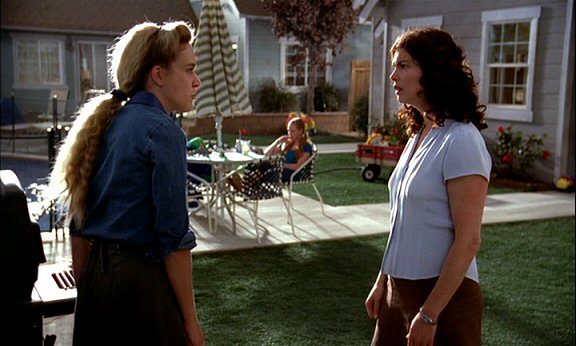
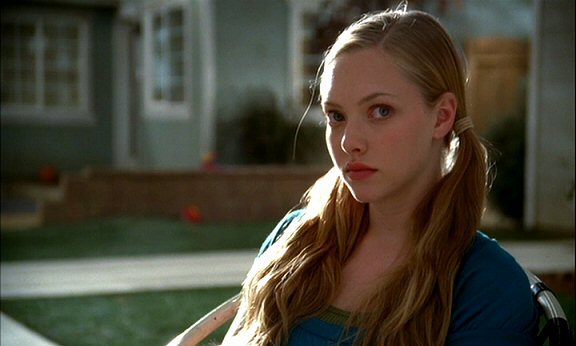
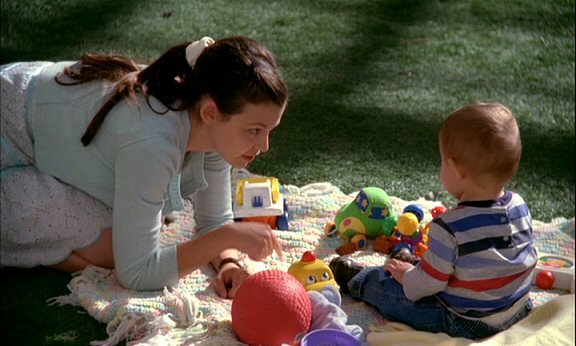
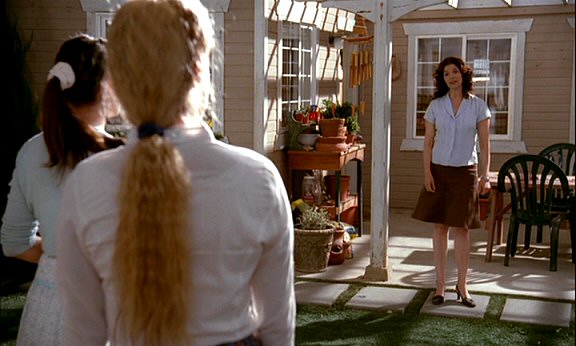
At each end of the soundstage, I have Dinos to create a backlight. Overhead are spacelights. On this last frame, though, I wanted a toppier backlight so I extended a 20K on a small condor with an articulating arm to get over the porch trellace and create that shadow pattern on the side of the house.
David,
The light on the actor's faces in these "outdoor" scenes is very soft. Were you using any key lights, or just some bounce with the spacelights as fill?
-
Mr. Beebe DP'd Chicago 2002, Collateral 2004, & Memeoirs of a Geisha 2005, to name three of his recent works.
-
In 1979 I was studying for a college exam in the college
library. I took a break from studying & went back in the
stacks to see what kind of magazines they had. Lo & Behold
there was a copy of American Cinematographer! I didn't
understand all the terminology, but I was hooked! I still
remember what was on the cover....Alien.



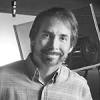
Chip Chart
in General Discussion
Posted
Thanks Much!